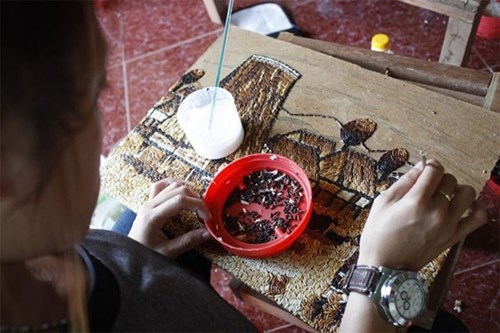Part of its long history in Central Highlands culture are rice paintings. The best place to witness these paintings is at Ho village, located at Bac Kan street, Kon Tum city. The village offers visitors a visual feast in art works.
The paintings vary from calligraphic, the daily activities of the local people to cultural features of ethnic groups and their traditional housing near Dak Bla River and big forests.
Painter Nguyen Kieu Dang, who founded the Ho village rice painting gallery, said that behind every painting was the happiness of the makers.
Each painting holds a different spiritual value. To be able to present that value to viewers is the true bliss of artists,” said Dang. “To me, giving soul to a painting is the hardest thing, since only truthful and vivid sketches create a good painting. The success of the artwork is also decided based on how the color of the rice fits into the painting.”
    |
 |
|
A tourist learns to make a rice painting under the guidance of Dang. |
Describing the procedure to develop a rice painting, Dang said that first, the idea was sketched on paper and then painted onto hard paper or plywood.
“The key here is choosing the rice and roasting it into different color tones. Depending on the roasting time, the color will turn from white to a darker tone, and finally to black. Roasting the rice is also the toughest part, as we are not allowed to let it burst open, break down or burn. Hands must be steady while roasting so the color is fresh,” she said.
The rice is then divided into small boxes and placed around the sketched painting. The artist then overlays the sketch with roasted rice, while picturing the light and dark area to be filled. The finishing touch is covering the work with polyurethane, which allows the color to remain intact.
A completed rice painting must be a perfect combination of the colors and sizes of the rice. The artist has to master the trick of putting the rice into the right position, either straight, down or crosswise.
Visitors to the gallery can observe 10 young people meticulously overlaying the rice on paintings by Dang. Besides painting, she also gives lectures to the poor and disabled young people to help create a livelihood for them.
Nguyen Thị Thanh Thao, who has been working at the gallery for three years under the guardianship of Dang, now creates rice paintings on her own, featuring local cultural highlights.
“I can now complete an entire rice painting on my own,” said Thao.
Rice paintings by Ho village are well known to tourists with artworks displayed at craft villages in Hoi An, Da Nang, Hanoi and HCM City. Several charity foundations in the US have ordered a large number of paintings priced from VND 200,000 (USD 10) to more than 2 million (USD 88), depending on the size.
At present, Dang is implementing a craft village tourism project at Kon Ktu Village. Her plan is to open one more rice-painting gallery at the village, so tourists can admire the artworks made by Dang and experience or create their own rice paintings.
According to Dang, the gallery at Kon Ktu will be completed at the end of the year and will be open for Tet (Lunar New Year).
Source: VNA